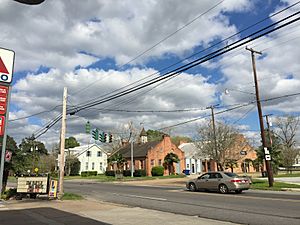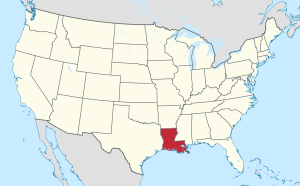Washington, Louisiana facts for kids
Quick facts for kids
Washington, Louisiana
|
|
|---|---|
|
Town
|
|
| Town of Washington | |
 |
|

Location of Washington in St. Landry Parish, Louisiana.
|
|

Location of Louisiana in the United States
|
|
| Country | United States |
| State | Louisiana |
| Parish | St. Landry |
| Area | |
| • Total | 0.85 sq mi (2.20 km2) |
| • Land | 0.83 sq mi (2.14 km2) |
| • Water | 0.02 sq mi (0.06 km2) |
| Elevation | 46 ft (14 m) |
| Population
(2020)
|
|
| • Total | 742 |
| • Density | 897.22/sq mi (346.23/km2) |
| Time zone | UTC-6 (CST) |
| • Summer (DST) | UTC-5 (CDT) |
| Area code(s) | 337 |
| FIPS code | 22-79870 |
Washington is a small town located in St. Landry Parish, Louisiana, United States. In 2020, about 742 people lived there. It is part of a larger area that includes the towns of Opelousas and Eunice. For much of the 1800s, Washington was a very important port. It was the biggest inland port between the cities of New Orleans and St. Louis.
Contents
Town Location and Size
Washington is found at coordinates 30°36′52″N 92°3′30″W. This means it is in the southern part of the United States.
The United States Census Bureau says the town covers about 0.9 square miles (2.2 square kilometers). Most of this area is land, and a very small part is water.
How Many People Live Here?
| Historical population | |||
|---|---|---|---|
| Census | Pop. | %± | |
| 1860 | 536 | — | |
| 1870 | 907 | 69.2% | |
| 1880 | 1,194 | 31.6% | |
| 1890 | 1,064 | −10.9% | |
| 1900 | 1,197 | 12.5% | |
| 1910 | 1,528 | 27.7% | |
| 1920 | 1,041 | −31.9% | |
| 1930 | 1,004 | −3.6% | |
| 1940 | 1,264 | 25.9% | |
| 1950 | 1,291 | 2.1% | |
| 1960 | 1,291 | 0.0% | |
| 1970 | 1,473 | 14.1% | |
| 1980 | 1,266 | −14.1% | |
| 1990 | 1,253 | −1.0% | |
| 2000 | 1,082 | −13.6% | |
| 2010 | 964 | −10.9% | |
| 2020 | 742 | −23.0% | |
| U.S. Decennial Census | |||
Population in 2020
In 2020, there were 742 people living in Washington. There were 382 households and 212 families.
The population was made up of different groups:
- About 40.7% were White (not Hispanic).
- About 55.26% were Black or African American (not Hispanic).
- A small number were Native American, or from other backgrounds.
- About 1.62% were Hispanic or Latino.
Population in 2010
In 2010, there were 964 people living in the town.
- About 52.8% were Black.
- About 43.2% were White.
- Other groups included Native American and Asian people.
- About 1.9% of the people were Hispanic or Latino.
A Look at Washington's Past
Washington has a rich history. It was once a very important place for trade and travel.
Early Schools and Challenges
The Grimble Bell School was in Washington. It was the first school for African American students in the area. It opened in the 1830s. Sadly, the school was forced to close in 1860.
The Civil War Years
During the American Civil War, soldiers from the Union army, led by General Nathaniel P. Banks, came to Washington. At that time, Washington was bigger than Opelousas, which was the main town of the parish.
The soldiers took many supplies from the towns. They took food, animals, cotton, and other goods. The value of these items was estimated to be more than ten million dollars.
After the Civil War
After the war, there were many challenges for formerly enslaved people, also called freedmen. They faced resistance as they tried to gain their rights, including the right to vote.
In 1868, before an election, some white Democrats in Washington did not allow African Americans to join their political party. Groups like the Seymour Knights caused problems for Black citizens in the town.
This led to a series of difficult events. African Americans marched towards Opelousas, and many were captured. This period included violence against African Americans in the area. This sad time is known as the Opelousas Massacre.
Traffic Rules and Town Income
Washington has been known for strictly enforcing traffic laws. This means that if you drive even a little bit over the speed limit, you might get a ticket.
In 2007, a report found that more than half of the town's money came from traffic fines. This was in the 2005 financial year. In 2009, the mayor at the time, Joseph Pitre, said the town collected between $700,000 and $800,000 each year from speeding tickets.
In 2014, State Representative Alan Seabaugh called Washington the most "notorious" speed trap in Louisiana. He wanted to change laws so that towns could only enforce traffic rules if they had a certain amount of land along a highway. Many people complained about getting tickets for driving only slightly over the speed limit.
Local Culture and History
Washington hosts an annual event called the Festival du Courtableau. It is now known as the Washington Catfish Festival.
The downtown area of Washington is very special. On November 15, 1978, it was added to the National Register of Historic Places. This means it is recognized as an important historical area. It is called the Washington Historic District.
Famous People from Washington
Some notable people have come from Washington:
- Oramel H. Simpson, who was a governor.
- Arthur T. Prescott, who was a president and administrator at a university.
Images for kids
See also
 In Spanish: Washington (Luisiana) para niños
In Spanish: Washington (Luisiana) para niños


